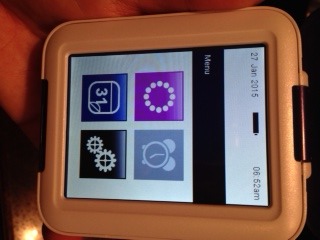 Thanks to Fertility Planit for sponsoring this post and giving me a Clearblue® Fertility Monitor. While I have received compensation for this post, all opinions are my own.
Thanks to Fertility Planit for sponsoring this post and giving me a Clearblue® Fertility Monitor. While I have received compensation for this post, all opinions are my own.
Eric and I have been married for almost five years now. When we first got married, we had no intention of becoming parents any time soon. We were still relatively young, we were pretty broke, and we just wanted to enjoy each other as a couple first before bringing in any more craziness to our little family of two (well three, if you count our furry child, Bentley).
We always knew we wanted to have kids, but the “when?” seemed to be the hardest problem to figure out. Eric had been working on his career to become a firefighter, I’ve been going to school for my master’s—there just never seemed to be a right time. And as any parent will tell you, it’s not like you’re ever really ready anyway.
So as we’ve started to become more and more open to the idea of possibly expanding our family, we were contacted by Fertility Planit about trying out the Clearblue® Fertility Monitor.
The Fertility Monitor with Touch Screen is an advanced fertility tracker that tracks two key fertility hormones. While most fertility kits only track one hormone, the Clearblue® Fertility Monitor tracks two: luteinizing hormone and estrogen. These two key fertility hormones help the device pinpoint your two peak fertility days, plus additional high fertility days prior to ovulation.
When I first received the monitor, I was surprised by how compact it was. It fits in the palm of my hand and is very easy to set up. I am one of the most computer-challenged people I know, and I was able to set this up on my own by following the directions in the booklet. The touchscreen monitor gives it an aura of modern technology and takes out the guesswork of having to decide if the line is dark enough, if it counts as a fertile day, if it’s only slightly dark enough…
There are too many variations and guesswork involved when using a normal fertility kit—the Clearblue® Fertility Monitor helps avoid all that by letting you know exactly when you’re at peak fertility.
I am actually really excited about using a fertility tracker. I have often struggled with irregular cycles. This makes it pretty hard to figure out when I’m actually ovulating. By having to take the guesswork out of my cycle, I can rely on the monitor to help pinpoint my highest peak fertility days.
Also, having a husband that works regular 24-hour shifts, sometimes 48-hour and 72-hour shifts, knowing my high fertility days in addition to peak days will also be helpful.
Over the next few weeks, I’ll be blogging about my experience using the Clearblue® Fertility Monitor and I invite you to follow along. If you have any specific questions, please feel free to ask them in the comments section below.
To learn more, follow @Clearblue on Facebook and Twitter. Join the conversation with #BabyMakingDays.

1 comment
Thank you for sharing your story, it helps people who are struggling with this sort of thing.